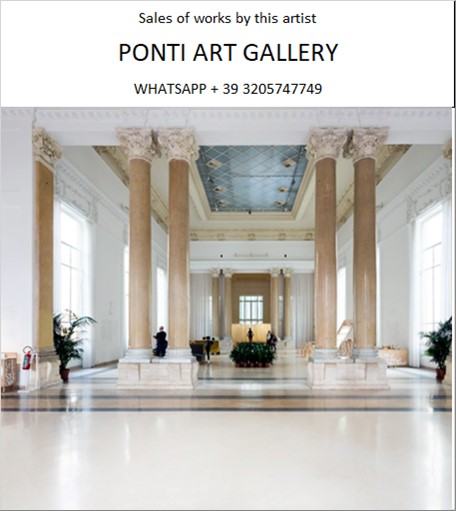Ponti Art Gallery is interested in buying and selling works
of art by this artist.

John La-Farge Biography
John La Farge was an American artist whose multifaceted career spanned across various forms of visual arts, including painting, mural creation, stained glass design, and writing. Born on March 31, 1835, in New York City to affluent French immigrants, La Farge was raised in a bilingual and culturally rich environment. His early education was comprehensive, with a focus on literature, French, and Roman Catholicism, which would later influence his artistic themes and motifs.
La Farge's artistic inclinations were evident from a young age. He received drawing lessons from his grandfather and learned watercolor techniques from an English artist whose name remains unknown. Despite this early exposure to art, La Farge initially pursued a different path, studying law at Mount Saint Mary's College in Maryland and Saint John's College in New York. However, his passion for art could not be sidelined for long. In 1856, La Farge traveled to Paris, where he was introduced to the city's elite literary and artistic circles, thanks to his family's connections. This trip was pivotal in shaping his artistic direction. He studied briefly with Thomas Couture and was influenced by the Pre-Raphaelite movement during his time in England.
Upon his return to the United States due to his father's illness, La Farge briefly resumed his legal studies but soon rented a studio in New York's Tenth Street Studio Building. It was here that he met architect Richard Morris Hunt, who would play a significant role in La Farge's decision to dedicate himself to painting. In 1859, La Farge moved to Newport, Rhode Island, to study with Hunt's brother, William Morris Hunt, further solidifying his commitment to art.
La Farge's early works included landscapes and figure compositions, reflecting the influence of progressive French landscape painting and Japanese prints, which he avidly collected. His artistic endeavors took a significant turn in the late 1860s when he began to explore murals and stained glass, mediums that would come to define his legacy. In 1876, La Farge received a commission that would mark a milestone in his career—the decoration of Trinity Church in Boston. His work there, particularly the stained glass windows, showcased his innovative use of opalescent glass, a technique he patented in 1880.
La Farge's contributions to the field of stained glass were groundbreaking. He was a pioneer in the American Renaissance movement, transforming the medium with his unique use of color, texture, and material. His stained glass works were not only visually stunning but also technically innovative, earning him international recognition and awards, including the Legion of Honor at the Paris International Exposition in 1889.
Despite his success in the decorative arts, La Farge continued to paint and was involved with the Society of American Artists, a group of progressive painters who opposed the conservative National Academy of Design. However, La Farge maintained membership in both organizations, exhibiting his work widely across the country.
An inveterate traveler, La Farge embarked on several trips to Europe and two notable voyages to the Pacific—Japan in 1886 and the South Seas in the late 1880s. These travels significantly influenced his work, as seen in the extensive series of watercolors and writings documenting his experiences. La Farge's literary contributions included articles, books, and lectures on art, which helped cover the expenses of his large-scale projects.
La Farge's personal life was as complex as his professional one. He married Margaret Perry in 1860, and they had eight children. His family life was centered in Rhode Island, but his work often kept him in Boston or New York, leading to a separation from his family. Despite his achievements, La Farge faced financial difficulties throughout his life, often struggling to pay his employees and manage his finances.
John La Farge passed away on November 14, 1910, in Providence, Rhode Island, at the age of 75. His legacy is that of an artist who not only mastered multiple mediums but also enriched American culture through his innovative and transformative approach to art. His work remains a testament to his ability to bridge diverse cultures and styles, from European to Asian to American, making him one of the most influential figures of the 19th-century American art scene.
John La-Farge Quotes and Sales
of Works
Ponti Art Gallery selects and deals with paintings by the
artist. Upon request, we provide free estimates and
evaluations, communicate prices, quotations, and current
market values.
If you are interested in BUYING or SELLING works by the
artist, contact us immediately.
If you wish to sell or receive an evaluation of the
works:
Send us a frontal photo of the painting, one of the back,
and one of the signature. Also, indicate the dimensions of
the work. Inform us about the purchase origin of the work
and any kind of available documentation (purchase
receipts, certificates of authenticity, publications). One
of our operators will respond to you on the same day. We
guarantee maximum confidentiality and extreme
professionalism.
If you wish to purchase works by the painter: Contact us
and let us know your request. We will inform you about the
available works. We also offer the possibility to
subscribe to our NEWSLETTER, through which you will be
informed at the beginning of each month about the latest
acquisitions of the art gallery.
You can send us pictures of the work:
